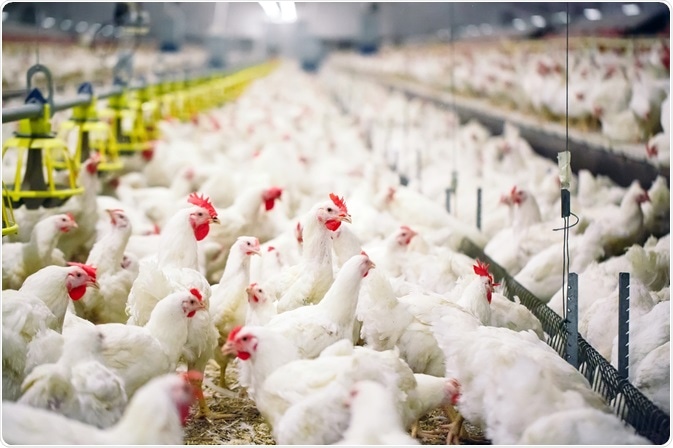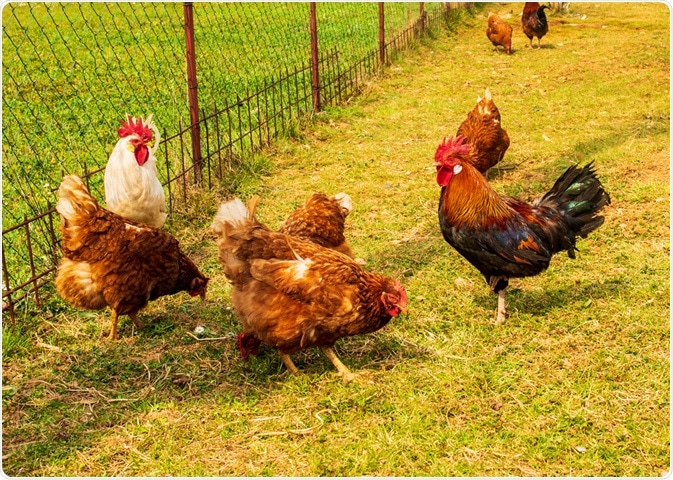Chicken is the most consumed form of protein across the US, with Americans eating 93 pounds of chicken per capita annually, more than anywhere else in the world.

Image Credit: vkuslandia/Shutterstock.com
In addition, the US is the world’s second-largest exporter of poultry, with 18% of the meat produced in the countries being sent around the globe.
In 2018, the U.S. Poultry and Egg Association estimated that the total poultry and egg market in the US, including broilers, eggs, turkeys, and chicken sales equaled to around $46.3 billion. In terms of pounds, the US poultry industry produces around 42.2 billion pounds annually, this is more than beef (26.3 billion), pork (25.6 billion), and turkey (5.9 billion).
The latest census reports that there are 233,770 poultry farms in the US, a figure which is expected to have risen in recent years.
Poultry farming is undoubtedly huge in the US, as well as the rest of the world. It has some benefits to other kinds of meat farming, such as that it emits fewer greenhouse gases.
Also, while the consumption of beef and pork has steadily fallen over the decades, the consumption of chicken has remained strong and continues to grow.
This is thought to be, at least partly, because chicken is considered to be a healthier meat, and as consumers become more health-conscious, their appetite for chicken over beef and pork grows.
Housing poultry
Poultry farming relies heavily on the housing that is used to keep the animals in. Recently, chicken farms have come under heavy criticism in the US and around the world due to their ethics. As a result, modern poultry farms are beginning to focus more and more on the conditions their animals are kept in, and this comes down to their housing.
There are various choices for housing birds, all of which have pros and cons. The most common type is still the conventional housing system which is constructed from either solid metal or mesh poultry cages. These cages usually can house between three and eight birds.
An overhead system is used to provide the animals with water, and generally, a trough is attached to the front of the cage to provide feed. Depending on the available floor space, the cages are stacked or spread out.
The major drawback of this method is that the birds do not have access to much space, and it is often considered unethical. There are other, similar types of housing, such as individual cages, colony cages (housing more than 11 animals per cage), multiple deck cages, battery cages, M-type cages, grower cages, and layer cages. However, all have the same disadvantage that the chickens are kept in small spaces.
Free-range poultry, on the other hand, is kept in housing that gives them access to the environment, such as static barns, mobile houses, and aviaries. The benefit of this housing is that the birds enjoy more ethical treatment. The downside is the cost of the larger spaces needed.

Image Credit: David Tadevosian/Shutterstock.com
Feeding poultry
In the US, poultry that is commercially raised in generally feed a complete feed the incorporates the right levels of protein, vitamins, minerals, and nutrients necessary to ensure proper growth and health.
Chickens are usually fed a high-protein diet until about six to eight weeks. Following this, they are fed a diet that is richer in energy than protein.
Europe vs the US
There has been a long-standing contrast between poultry farming in the US and Europe. The latter focuses on a “farm to fork” mentality, where steps are taken to ensure the meat that arrives in stores is traceable to the farm.
This sense of accountability often results in higher quality conditions for the animals, higher quality meat, and reduced transportation which indirectly leads to fewer emissions.
In the US, a mild chlorinated spray is used to reduce the levels of bacteria on the chicken’s surface. Because of this, US chicken has been banned in Europe for the past two decades.
The impact of poultry farming
Fossil fuels are heavily relied upon by the poultry industry, which means that poultry farming has a significant carbon footprint. Electricity and propane are commonly used in farming processes related to poultry farming.
In addition, diesel is often used in vehicles used to transport the products, as well as to power the generators on the farm. Methane and nitrous oxide are also released into the atmosphere as a result of poultry farming due to the manure.
While the poultry industry harms the environment because of its contribution to emissions, it emits fewer greenhouse gases than beef and pork farming. It is considered that switching from eating beef to chicken would have the impact of cutting the average American’s dietary carbon footprint by roughly 50%.
Recent studies have shown that emissions released by enteric fermentation, produced when animals break down carbohydrates, are much higher for cattle which produces 185 to 271 pounds of methane per animal each year, then for poultry (0.57 pounds).
However, the size difference between the animals should be taken into consideration.
Sustainability and the future of poultry farming
The future of poultry farming will likely focus on making a transition to becoming more sustainable and environmentally friendly. As pressures mount to tackle climate change, all industries are being forced to revise their processes to limit the emissions that they contribute.
In addition, consumers are becoming more conscious of the food they are eating, this is motivating them to buy products that have a limited impact on the environment and animals. This means that more than ever before they are leaning towards buying from more ethical producers.
Poultry farming is likely to adapt to these needs and motivations to remain connected with consumers.

Image Credit: Samir Behlic/Shutterstock.com
Sources:
- Alders, R., Costa, R., Gallardo, R., Sparks, N., and Zhou, H., 2019. Smallholder Poultry: Leveraging for Sustainable Food and Nutrition Security. Encyclopedia of Food Security and Sustainability, pp.340-346. https://www.sciencedirect.com/science/article/pii/B9780081005965215448
- American chicken is incompatible with European farming. Available at: www.poultryworld.net/.../
- Choosing chicken over beef cuts our carbon footprints a surprising amount. Available at: www.nationalgeographic.co.uk/.../choosing-chicken-over-beef-cuts-our-carbon-footprints-surprising-amount
- Global Warming: How Does It Relate to Poultry? Available at: extension.uga.edu/.../detail.html
- The United States Meat Industry at a Glance. Available at: https://www.meatinstitute.org/index.php?ht=d/sp/i/47465/pid/47465
- USDA Poultry Production Data. Available at: www.usda.gov/.../nass-poultry-stats-factsheet.pdf
- When and how to start a poultry farm. Available at: www.agriculture.com/.../when-and-how-to-start-a-poultry-farm
Further Reading
Last Updated: May 26, 2020